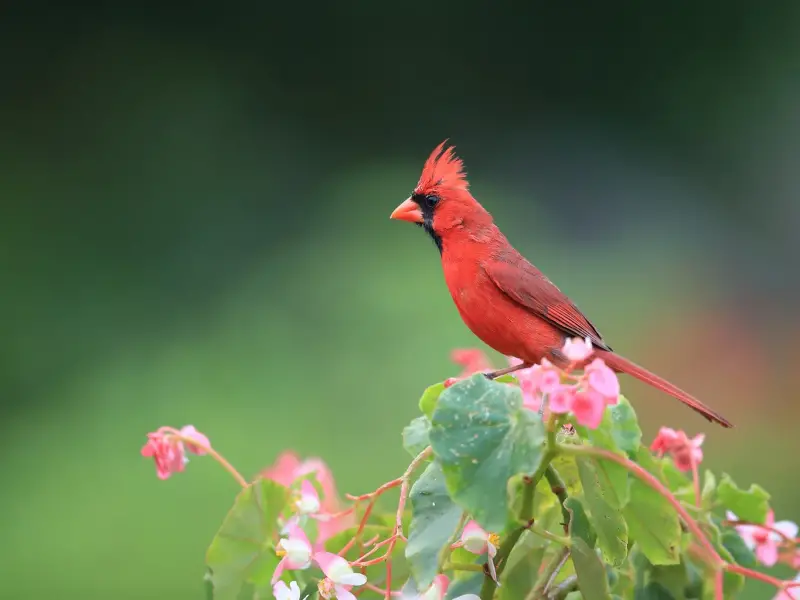The vibrant red cardinal is one of the most striking birds you can encounter in Hawaii, captivating residents and visitors alike with its bright plumage and cheerful song. While the islands are famous for their native tropical birds, the presence of the red cardinal, officially known as the Northern Cardinal (Cardinalis cardinalis), adds a unique and colorful twist to Hawaii’s avian diversity. This introduced species has adapted remarkably well to the islands’ warm climate and lush vegetation, making it a familiar sight in gardens, parks, and forested areas.
In this article, we will explore the fascinating world of red cardinals in Hawaii, including their origin, physical characteristics, behaviors, diet, and the habitats where they thrive. We will also discuss their ecological impact and why these birds have become a beloved part of Hawaii’s landscape.
The Arrival of Red Cardinals in Hawaii

The red cardinal is not native to Hawaii. Its introduction to the islands dates back to the late 1920s and early 1930s, when these birds were brought from North America as ornamental species. They were released intentionally for aesthetic purposes, as their bright plumage and melodic song were considered a beautiful addition to the islands’ bird population.
Over time, red cardinals established breeding populations across several Hawaiian islands, including Oahu, Maui, Kauai, and the Big Island. Their success in colonizing these regions is largely due to Hawaii’s mild climate, abundant food sources, and lack of significant predators. Unlike some other introduced species that have disrupted native ecosystems, red cardinals have integrated relatively peacefully, coexisting with both native and other introduced birds.
The introduction of these birds reflects a historical trend of acclimatizing exotic species for aesthetic reasons. Today, they are considered naturalized residents and have become part of Hawaii’s distinctive birdwatching experience.
Physical Characteristics of Red Cardinals in Hawaii
The red cardinal’s vivid appearance makes it one of the most easily recognizable birds in Hawaii. Males are known for their brilliant crimson plumage, which glows almost like a jewel against the island’s green foliage. They have a distinctive black mask around the face that extends to the throat, contrasting sharply with their red feathers. Their crest, a tuft of feathers on top of the head, adds to their striking silhouette.
Female red cardinals, in contrast, are more subdued in color. They are mostly light brown or tan with reddish tinges on the wings, crest, and tail. This coloration provides better camouflage, especially during nesting, while still retaining a touch of elegance.
Both males and females have strong, cone-shaped orange-red bills perfectly designed for cracking seeds. Their average size ranges from 8 to 9 inches in length, with a wingspan of around 10 to 12 inches. Despite their relatively small size, they are sturdy and agile, capable of quick movements as they forage or dart between branches.
The red cardinals in Hawaii show no major physical differences from their mainland counterparts, but their bright coloration tends to stand out even more vividly against the tropical backdrops of hibiscus, palm trees, and dense rainforests.
Habitats and Distribution Across the Hawaiian Islands
Red cardinals are found throughout many regions of Hawaii, adapting to diverse habitats with remarkable ease. They thrive in suburban gardens, agricultural lands, open forests, and coastal shrublands. Their ability to utilize both native and introduced plant species gives them a wide ecological range.
On Oahu, they are commonly seen in residential neighborhoods, particularly where gardens and fruit trees are abundant. In Maui and Kauai, they inhabit forest edges and open woodland areas, often perching on fence posts or telephone wires where their bright red feathers are easy to spot. The Big Island also supports healthy populations, especially in areas with a mix of grassland and scattered trees.
Their preference for low to mid-elevation habitats means they are rarely seen in high-altitude rainforests. They are most abundant in places with dense vegetation for nesting and open spaces for foraging. Unlike some shy native birds, red cardinals are not afraid of human presence, making them frequent visitors to backyards and bird feeders.
Behavioral Traits and Daily Life
The behavior of red cardinals in Hawaii mirrors that of their mainland relatives. They are primarily diurnal, active from early morning until late afternoon. Their melodic songs often fill the air at sunrise, marking their territories and attracting mates. Males are especially vocal during the breeding season, singing loudly from exposed perches to proclaim their presence.
Red cardinals are monogamous birds, often forming long-term pair bonds. During courtship, males engage in a charming display where they feed seeds to the female as a bonding gesture. Once paired, they work together to build nests, typically placing them in dense shrubs or low trees where they remain concealed from predators.
Their territorial behavior becomes more pronounced during breeding, with males fiercely defending their chosen area from rivals. Outside the breeding season, however, they can sometimes be seen in loose flocks, especially around abundant food sources.
Another fascinating behavioral trait is their tendency to attack their reflections in windows or mirrors. Mistaking the reflection for a rival, cardinals repeatedly peck at glass surfaces, a behavior commonly reported by residents who attract these birds to their yards.
Diet and Feeding Habits
Red cardinals are primarily granivorous, with seeds forming the bulk of their diet. Their strong beaks are specially adapted for cracking open seeds of various plants. In Hawaii, they readily consume seeds from both native and introduced species, including grasses, shrubs, and ornamental plants.
They also supplement their diet with fruits, berries, and insects. This omnivorous tendency becomes particularly important during the breeding season when they require extra protein to feed their chicks. Fruits such as guava, papaya, and other cultivated varieties often attract cardinals to residential gardens, making them a welcome sight for homeowners who enjoy birdwatching.
Their foraging behavior is mostly ground-based, hopping along lawns, forest floors, and agricultural fields in search of fallen seeds or insects. However, they are also adept at picking fruits directly from shrubs and small trees.
The adaptability of their diet has played a significant role in their success as an introduced species. With a year-round supply of food in Hawaii’s warm climate, red cardinals rarely face seasonal scarcity.
Breeding and Nesting in Hawaii
Breeding season for red cardinals in Hawaii can occur nearly year-round due to the tropical climate, but it peaks during spring and early summer. Their nests are carefully constructed cups made of twigs, grasses, and other plant fibers, often hidden within thick foliage to protect against predators.
The female is primarily responsible for nest building, while the male provides food and defends the territory. A typical clutch consists of three to four eggs, which are pale gray or greenish with darker speckles. The female incubates the eggs for about two weeks, after which both parents take turns feeding the chicks.
Fledglings leave the nest after about 10 to 12 days but continue to rely on parental care for several weeks. The extended breeding season in Hawaii allows some pairs to raise multiple broods in a year, contributing to the stability of their population.
Ecological Impact and Role in Hawaii
The introduction of red cardinals to Hawaii has sparked discussions about their ecological role. Unlike some invasive species, cardinals have not caused significant harm to native bird populations. Their diet overlaps more with other introduced birds than with native species, and they are not major nest predators.
In some ways, they play a beneficial role by aiding in seed dispersal, particularly for ornamental and fruit-bearing plants. However, they can contribute to the spread of invasive plant species by consuming and dispersing seeds of non-native plants.
Overall, their ecological impact is considered moderate, and they are widely appreciated for their beauty and song rather than viewed as pests. Conservation efforts in Hawaii focus more on protecting endangered native species rather than controlling cardinal populations.
Fun Facts About Red Cardinals in Hawaii
One of the most charming aspects of red cardinals is their symbolic significance. In many cultures, including in Hawaii, they are seen as symbols of love, hope, and even spiritual messengers. Their bright red color and melodious song often bring joy to those who spot them.
Cardinals are also known for their loyalty, often staying in the same area year-round rather than migrating long distances. This makes them a familiar and comforting presence in gardens and parks across the islands.
Their willingness to approach human settlements has made them favorites among photographers and birdwatchers. It is not uncommon to see them hopping confidently near feeders or perching boldly on low branches, providing excellent opportunities for close observation.
FAQs About Red Cardinals in Hawaii
Are Red Cardinals Native to Hawaii?
No, red cardinals are not native to Hawaii. They were introduced to the islands in the late 1920s and early 1930s for ornamental purposes. Over time, they established stable populations on several islands, including Oahu, Maui, Kauai, and the Big Island.
Where Can You See Red Cardinals in Hawaii?
Red cardinals are commonly seen in gardens, parks, open forests, and agricultural lands. They are especially abundant in residential areas where fruit trees, shrubs, and bird feeders provide easy food sources.
What Do Red Cardinals Eat in Hawaii?
Their diet mainly consists of seeds, fruits, and insects. In Hawaii, they often feed on seeds of both native and introduced plants, as well as fruits like guava and papaya. During breeding, they consume more insects to feed their chicks.
Do Red Cardinals Harm Native Birds in Hawaii?
Red cardinals have not caused major harm to native bird populations. Their diet and nesting habits overlap more with other introduced birds rather than native species, so their ecological impact is considered moderate.
Can You Attract Red Cardinals to Your Garden in Hawaii?
Yes, red cardinals are easily attracted to gardens with fruit trees, seed feeders, and dense shrubs for nesting. Providing water sources also encourages them to visit regularly.
Conclusion
Red cardinals have become a charming part of Hawaii’s birdlife, admired for their vivid red plumage and pleasant songs. Their adaptability to various habitats and peaceful coexistence with native species make them a welcome sight across the islands. Observing these birds not only adds beauty to everyday life but also deepens appreciation for Hawaii’s unique wildlife.






